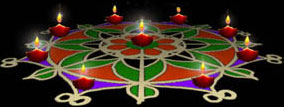|
The
Making of Dipawali Rangoli
Diwali, the festival of
lights - time to enjoy with family and friends, eating specially made
sweets and savouries, light diyas, burst crackers and dress up to look
your dazzling best.
Apart from decorating
lighting up your home with diyas or candles, why not bring in some
colour as well? We are referring to rangoli, the traditional art of
decorating floors with patterns using coloured powder. Although this art
is Maharashtrian in origin, it has become quite popular all over the
country.
If you want to create
your own rangoli this diwali, we shall help you out with the basics
What
you will need to create a rangoli?
The rangoli patterns
are usually made with rice powder that has been coloured with dyes. You
can get lovely, bright colours to make your designs with. Most shops
that sell diwali related items like diyas and crackers stock rangoli
powder. You can even use flower petals, cereals (the orange and yellow
coloured dal), turmeric powder, to lend colour to your rangoli.
You will also need a
piece of chalk to draw the outline of the rangoli design on the floor.
How
to create the rangoli?
Choose a design that
you want to draw. You may find designs from books and magazines or you
may try to create your own design. Rangoli designs are symmetrical in
nature and geometric in shape.
If you want to try out
a design of your own, first draw it on a piece of paper and fill in the
design with coloured sketch pens to get an idea about how the rangoli
will look.
Wipe the floor (where you
want to create the rangoli) with a wet cloth and wait for the area to
dry.
With a piece of chalk,
first draw the outline of the rangoli design.
Now it's time to fill
in the outline with rangoli powder, the most challenging part of the
whole exercise! Pick up some powder with your thumb and index finger and
fill in the design by rubbing the two fingers together and sprinkling
the powder on the floor. Take care to sprinkle the powder carefully,
don't let powders of two different colours merge with each other.
You may create spaces
within the rangoli design to place diyas. You could also use flower
petals of different colours (golden marigolds, bright red roses) to add
that extra dimension to your design.
With a little bit of
imagination, a dash of aesthetic sense and dollops of patience, you can
create a piece of art that will add lots of colour to your diwali
celebarations!
The
Tradition of Rangoli
Rangoli
Patterns
|